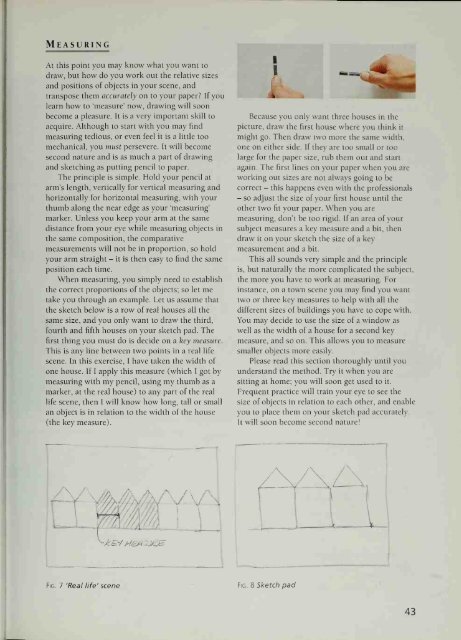A Brush With Art.pdf
You also want an ePaper? Increase the reach of your titles
YUMPU automatically turns print PDFs into web optimized ePapers that Google loves.
MeasuringAt this point you may know what you want todraw, but how do you work out the relative sizesand positions of objects in your scene, andtranspose them accurately on to your paper? If youlearn how to 'measure' now, drawing will soonbecome a pleasure. It is a very important skill toacquire. Although to start with you may findmeasuring tedious, or even feel it is a little toomechanical, you must persevere. It will becomesecond nature and is as much a part of drawingand sketching as putting pencil to paper.The principle is simple. Hold your pencil atarm's length, vertically for vertical measuring andhorizontally for horizontal measuring, with yourthumb along the near edge as your 'measuring'marker. Unless you keep your arm at the samedistance from your eye while measuring objects inthe same composition, the comparativemeasurements will not be in proportion, so holdyour arm straight - it is then easy to find the sameposition each time.When measuring, you simply need to establishthe correct proportions of the objects; so let metake you through an example. Let us assume thatthe sketch below is a row of real houses all thesame size, and you only want to draw the third,fourth and fifth houses on your sketch pad. Thefirst thing you must do is decide on a key measure.This is any line between two points in a real lifescene. In this exercise, I have taken the width ofone house. If I apply this measure (which I got bymeasuring with my pencil, using my thumb as amarker, at the real house) to any part of the reallife scene, then 1will know how long, tall or smallan object is in relation to the width of the house(the key measure).Because you only want three houses in thepicture, draw the first house where you think itmight go. Then draw two more the same width,one on either side. If they are too small or toolarge for the paper size, rub them out and startagain. The first lines on your paper when you areworking out sizes are not always going to becorrect - this happens even with the professionals- so adjust the size of your first house until theother two fit your paper. When you aremeasuring, don't be too rigid. If an area of yoursubject measures a key measure and a bit, thendraw it on your sketch the size of a keymeasurement and a bit.This all sounds very simple and the principleis, but naturally the more complicated the subject,the more you have to work at measuring. Forinstance, on a town scene you may find you wanttwo or three key measures to help with all thedifferent sizes of buildings you have to cope with.You may decide to use the size of a window aswell as the width of a house for a second keymeasure, and so on. This allows you to measuresmaller objects more easily.Please read this section thoroughly until youunderstand the method. Try it when you aresitting at home; you will soon get used to it.Frequent practice will train your eye to see thesize of objects in relation to each other, and enableyou to place them on your sketch pad accurately.It will soon become second nature!1^Fig. 7 'Real life' scene Fig. 8 Sketch pad43


